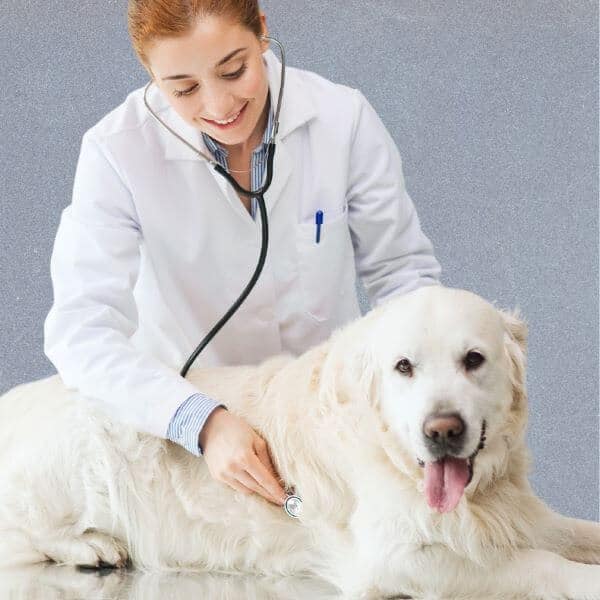Best Pet Insurance For Labrador Retrievers 2024: Must-Knows & Reviews

Canine Bible is reader-supported. We receive affiliate commissions via some of our links. This doesn’t affect rankings. Learn more.
This is the most comprehensive guide to finding the best pet insurance for Labrador Retrievers. There’s no way to predict the future. You don’t know if your dog will get sick or hurt unexpectedly or how much it will cost. What if your Lab picks up a virus or tears its ACL at the dog park? Or worse, what if he develops a chronic health problem? Like us, dogs can catch serious diseases or get hurt in an accident that could cost thousands of dollars at the vet. For peace of mind and to reduce the risk of an expensive vet bill, you may want to invest in pet insurance. Here are our top picks for the best pet insurance providers that offer coverage for adult and puppy Labrador Retrievers and breed-specific reasons you need to consider pet insurance. Let’s dive right in!

Why you should trust us: Our writers, editors, and in-house veterinarians spend hours analyzing and reviewing products and services to help find what’s best for you. Read the product review methodology and editorial mission to find out how we test, analyze, and rate.
Best Labrador Retriever Pet Insurance — At A Glance
What Is Labrador Retriever Pet Insurance: Pet insurance is a healthcare policy that provides coverage for your pet, offering reimbursement for specific veterinary expenses. This ensures that your savings remain secure despite unforeseen medical costs. Such a policy involves a monthly premium. Should your pet fall ill or sustain an injury, you would file a claim with the insurance company to recoup your expenses.

The monthly premium for Labrador Retriever pet insurance
$45 to $77
How Much Does Pet Insurance Cost For Labrador Retriever?
The cost of pet insurance for a Labrador Retriever dog will vary based on several factors, including the pet’s existing health conditions, sex, age, and the area you reside in. It’s important to remember that with the progression of veterinary technology and increased claims within your locality, your insurance premiums may rise. For example, even if your Labrador Retriever is quoted at $55 per month, this rate is not fixed and could change.
According to our research, plans for Labrador Retriever can range from $45 to $77. You may spend more or less depending on where you live, the deductible rate and the reimbursement percentage you choose. Labrador Retriever owners can expect to pay an average $59 monthly premium.
Pet Insurance Quotes For Labrador Retriever
We compared quotes from renowned pet insurance providers to estimate your expected average monthly premium for different life stages in Labrador Retrievers.
| Company | Deductible | Reimbursement | Annual Reimbursement Limit | Monthly Price | Location | Gender | Breed | Age |
|---|---|---|---|---|---|---|---|---|
| Lemonade | $500 | 70% | $100,000 | $49.23 | SC, 29044 | Male | Labrador Retriever | 6 years |
| Spot | $500 | 70% | Unlimited | $71.48 | SC, 29044 | Male | Labrador Retriever | 6 years |
| Healthy Paws | $500 | 70% | Unlimited | $60.96 | SC, 29044 | Male | Labrador Retriever | 6 years |
| Lemonade | $500 | 70% | $100,000 | $44.79 | CA, 95842 | Female | Labrador Retriever | 2 year |
| Spot | $500 | 70% | Unlimited | $75.16 | CA, 95842 | Female | Labrador Retriever | 2 year |
| Healthy Paws | $500 | 70% | Unlimited | $49.80 | CA, 95842 | Female | Labrador Retriever | 2 year |
| Lemonade | $500 | 70% | $100,000 | $48.12 | TX, 75219 | Female | Labrador Retriever | 6 months |
| Spot | $500 | 70% | Unlimited | $77.33 | TX, 75219 | Female | Labrador Retriever | 6 months |
| Healthy Paws | $500 | 70% | Unlimited | $54.07 | TX, 75219 | Female | Labrador Retriever | 6 months |
Labrador Retriever puppy monthly cost: $60
Adult Labrador Retriever monthly cost: $57
Senior Labrador Retriever monthly cost: $61
Is Pet Insurance For Labrador Retriever Worth it?
The decision to purchase pet insurance for your Labrador Retriever hinges on various factors, including your pet’s health risk proclivity, tolerance for financial risk, and overall financial circumstances.
Consider a scenario where your Labrador Retriever falls seriously ill or suffers an injury from an accident, incurring veterinary bills in the thousands. On average, the most common dog treatments cost $254.[1] A more severe and common condition in Labrador Retrieves, like Cancer, can cost between $3,000 and $8,000 to diagnose and treat. Can you pay for an unexpected $8,000 veterinary bill out-of-pocket? Most people can’t. The Federal Reserve states that 40% of Americans don’t have enough savings to cover a $400 emergency and 57% of U.S. adults cannot afford a $1,000 emergency expense.[2]
Investing in pet insurance for your Labrador Retriever is a wise choice to protect your finances and ensure your dog can receive the necessary care. With pet insurance, should an unexpected accident or illness occur, you could be reimbursed for 70% to 100% of the veterinary costs, depending on the details of your plan and provider. Pet insurance gives peace of mind, knowing your finances and pet’s health are covered.
Predict & Protect Your Labrador Retriever’s Future Health
Canine Bible uses years of clinical health findings, pet insurance data points, trends, and surveys to identify common health conditions in dogs. By gaining insight into your Labrador Retriever’s potential future health issues and risks, you can take preventive action today and ensure that your Labrador Retriever does not become a part of these statistics.
1 in 3
dogs will need emergency veterinary treatment every year.
$250 to $8K
is the average cost of unexpected veterinary care for dogs.[3]
#1 cause of death
in Labradors are musculoskeletal disorders & cancer.
22.7%
of Labrador Retrievers develop gastrointestinal disorders.[4]
Unfortunately, 61.6% of Labrador Retrievers had at least one disorder. Another interesting finding is that Chocolate Labrador Retrievers have a significantly shorter lifespan than non-chocolate dogs. The median lifespan for chocolate Labradors is 10.7 years, 1.4 years shorter than black or yellow Labradors.
If you know your dog’s breed is predisposed to certain health issues, we strongly advise getting a pet insurance policy while your dog is still healthy. Chronic health conditions, emergencies, and vet visits can rack up costs throughout your Labrador Retriever’s life. Pet Insurance can spare you a lot of financial trouble.
Dogs that develop chronic conditions under pet insurance coverage are guaranteed reimbursement for these issues for the duration of their life.Most Common Health Conditions In Labrador Retrievers
Cost to treat cardiomyopathy
Cardiomyopathy in dogs refers to heart muscle diseases impairing the heart’s ability to pump blood effectively. This condition can lead to heart enlargement, diminished cardiac function, and ultimately heart failure.
*The overall cost of diagnosing and treating illnesses and injuries may vary. The above cost is based on average veterinary vet bill reports and claims submitted by pet insurance policyholders. We’ve used a 90% reimbursement rate for this scenario.
Cost to treat cardiomyopathy
Cancer in dogs is the abnormal growth of cells in their body, often leading to tumors. It can affect any organ, showing varied symptoms, and requires veterinary diagnosis and treatment.
*The overall cost of diagnosing and treating illnesses and injuries may vary. The above cost is based on average veterinary vet bill reports and claims submitted by pet insurance policyholders. We’ve used a 90% reimbursement rate for this scenario.
Cost to treat ear infections
Ear infections in Labrador Retrievers are common due to their floppy ears, which trap moisture and debris, creating a breeding ground for bacteria and yeast. Symptoms include scratching, redness, and odor. Regular cleaning and veterinary care are essential for prevention and treatment.
*The overall cost of diagnosing and treating illnesses and injuries may vary. The above cost is based on average veterinary vet bill reports and claims submitted by pet insurance policyholders. We’ve used a 90% reimbursement rate for this scenario.
Cost to treat entropion
Entropion in Labrador Retrievers is a condition where the eyelid rolls inward, causing eyelashes to rub against the cornea. This results in discomfort, tearing, and potential corneal damage. It’s often inherited, though can also arise from eyelid injuries or muscular spasms. Treatment typically involves surgical correction.
*The overall cost of diagnosing and treating illnesses and injuries may vary. The above cost is based on average veterinary vet bill reports and claims submitted by pet insurance policyholders. We’ve used a 90% reimbursement rate for this scenario.
Cost to treat hip dysplasia
Hip dysplasia involves abnormal development of the hip joint, leading to looseness and instability. This genetic disorder is exacerbated by rapid growth, obesity, and environmental factors. Symptoms include limping, difficulty in movement, and arthritis.
*The overall cost of diagnosing and treating illnesses and injuries may vary. The above cost is based on average veterinary vet bill reports and claims submitted by pet insurance policyholders. We’ve used a 90% reimbursement rate for this scenario.
Cost to treat cataracts
Cataracts in Labrador Retrievers result in the lens of the eye becoming opaque, significantly impairing vision. Often hereditary, they can also arise from aging, diabetes, or eye injuries. Initially, cataracts may cause slight visual disturbances but can progress to blindness. Surgical removal is the primary treatment to improve sight.
*The overall cost of diagnosing and treating illnesses and injuries may vary. The above cost is based on average veterinary vet bill reports and claims submitted by pet insurance policyholders. We’ve used a 90% reimbursement rate for this scenario.
Cost to treat patellar luxation
Patellar luxation in Labrador Retrievers involves the dislocation of the kneecap from its normal position. This condition, often genetic, can cause lameness or an abnormal gait. Factors like trauma or congenital defects contribute to its development. Severity varies, potentially leading to arthritis or reduced mobility in affected dogs.
*The overall cost of diagnosing and treating illnesses and injuries may vary. The above cost is based on average veterinary vet bill reports and claims submitted by pet insurance policyholders. We’ve used a 90% reimbursement rate for this scenario.
Cost to treat fold dermatitis
In Labrador Retrievers, fold dermatitis occurs due to its distinctive facial structure, which creates skin folds where moisture and friction promote bacterial and yeast growth. This results in inflammation, infection, and irritation in these folds. Effective prevention includes consistent cleaning and vigilance to maintain skin health in these areas.
*The overall cost of diagnosing and treating illnesses and injuries may vary. The above cost is based on average veterinary vet bill reports and claims submitted by pet insurance policyholders. We’ve used a 90% reimbursement rate for this scenario.
Cost to treat portosystemic shunts
Portosystemic shunts in dogs involve abnormal blood vessel connections allowing blood to bypass the liver, leading to unfiltered blood reaching systemic circulation. This condition can cause toxins to accumulate, affecting neurological and digestive health. It’s often congenital, resulting from genetic predispositions in this breed.
*The overall cost of diagnosing and treating illnesses and injuries may vary. The above cost is based on average veterinary vet bill reports and claims submitted by pet insurance policyholders. We’ve used a 90% reimbursement rate for this scenario.
Cost to treat elbow dysplasia
A common issue in large breeds, elbow dysplasia in Labrador Retrievers stems from abnormal development of the elbow joint, leading to joint laxity, pain, and lameness. Genetics play a significant role, and it can be exacerbated by rapid growth during puppyhood or improper nutrition.
*The overall cost of diagnosing and treating illnesses and injuries may vary. The above cost is based on average veterinary vet bill reports and claims submitted by pet insurance policyholders. We’ve used a 90% reimbursement rate for this scenario.
Cost to treat osteochondrosis of the ankle/knee
This occurs when joints’ cartilage fails to develop properly in growing dogs, often due to rapid growth, genetics, or nutrition. It leads to joint pain and lameness in affected areas.
*The overall cost of diagnosing and treating illnesses and injuries may vary. The above cost is based on average veterinary vet bill reports and claims submitted by pet insurance policyholders. We’ve used a 90% reimbursement rate for this scenario.
Cost to treat exercise-induced collapse
Triggered by strenuous activity, this neuromuscular disorder causes Labrador Retrievers to suffer from muscle weakness, collapse, and sometimes temporary paralysis post-exercise.
*The overall cost of diagnosing and treating illnesses and injuries may vary. The above cost is based on average veterinary vet bill reports and claims submitted by pet insurance policyholders. We’ve used a 90% reimbursement rate for this scenario.
Cost to treat arthritis
A result of ongoing wear and tear on the joints, or as a complication from injuries or obesity. It causes chronic joint pain, stiffness, and swelling, reducing mobility.
*The overall cost of diagnosing and treating illnesses and injuries may vary. The above cost is based on average veterinary vet bill reports and claims submitted by pet insurance policyholders. We’ve used a 90% reimbursement rate for this scenario.
Cost to treat lipoma
These are benign fatty tumors common in older Labs, likely due to genetic predispositions. Generally harmless, they appear as soft, movable lumps under the skin.
*The overall cost of diagnosing and treating illnesses and injuries may vary. The above cost is based on average veterinary vet bill reports and claims submitted by pet insurance policyholders. We’ve used a 90% reimbursement rate for this scenario.
Cost to treat kennel cough
A contagious respiratory infection in Labradors, characterized by a persistent cough. It’s commonly contracted from other dogs and caused by bacterial or viral infections.
*The overall cost of diagnosing and treating illnesses and injuries may vary. The above cost is based on average veterinary vet bill reports and claims submitted by pet insurance policyholders. We’ve used a 90% reimbursement rate for this scenario.
Cost to treat papilloma
These are wart-like growths in the mouth or skin caused by a viral infection. Mostly benign, they are common in younger dogs and often resolve without treatment.
*The overall cost of diagnosing and treating illnesses and injuries may vary. The above cost is based on average veterinary vet bill reports and claims submitted by pet insurance policyholders. We’ve used a 90% reimbursement rate for this scenario.
Cost to treat dental disease
Poor dental hygiene in Labradors leads to plaque build-up, gingivitis, and periodontitis. This results in tooth loss, bad breath, and can affect overall health.
*The overall cost of diagnosing and treating illnesses and injuries may vary. The above cost is based on average veterinary vet bill reports and claims submitted by pet insurance policyholders. We’ve used a 90% reimbursement rate for this scenario.
Why Get Pet Insurance For Labrador Retrievers?
Benefits For Labrador Retrievers
Benefits For Owners
How to Pick The Best Labrador Retriever Pet Insurance
Best Pet Insurance For Labrador Retrievers
1. Best Overall Labrador Retriever Pet Insurance
Why we picked and recommended it: We named Lemonade our best overall pet insurance for Labrador Retrievers for its comprehensive coverage, pricing, availability, and customer service. Lemonade premiums usually start at just $10 monthly, the lowest in the industry. We ran a few quotes for a healthy Labrador Retriever at a $500 deductible and 70% coverage to estimate your monthly premium. Based on our research, you can expect to pay between $45 and $49 monthly. We love that Lemonade is tech-forward, making it easy to manage your policy and file claims through an app. Their plans cover accidents and illnesses, including injuries, poisonings, broken bones, sprains, infections, general sicknesses, cancer, heart disease, hip dysplasia, hernias, skin conditions and more. They also offer several add-ons to help pet owners pay for exam fees, physical therapy, and preventive care.
2. Best Personalized Labrador Retriever Pet Insurance
Why we picked and recommended it: Spot Pet Insurance offers seven annual limit options, three reimbursement levels, and five annual deductibles. They offer the lowest deductible in the industry ($100), meaning that when your Labrador Retriever gets sick, you pay less upfront before your plan starts paying. With so many customization options, this company is our top pick for finding a plan for meeting your specific financial needs and those of your pet. Spot’s policies also cover some items, such as exam fees and microchipping, that many other pet insurance providers don’t offer. They also have one of the cheapest plans for accident-only coverage, making it perfect for pet owners who only need minimal coverage. We ran a few quotes for a healthy Labrador Retriever at a $500 deductible and 70% coverage, based on our research, you can expect to pay between $71 and $77, but prices may vary depending on your location, Labrador Retriever’s age, and other factors. Spot covers you when your Labrador Retriever gets hurt unexpectedly, from tooth extractions and torn ligaments to surgery and hospitalizations.
3. Best No-Cap Payout Labrador Retriever Pet Insurance
Why we picked and recommended it: Healthy Paws offers the benefit of no cap payout, meaning there’s no maximum limit on the amount they will pay, which is particularly advantageous for severe conditions or chronic diseases that require ongoing, expensive treatments. With no financial cap, you can choose the best treatments for your pet. This can include access to advanced medical procedures, specialized surgeries, or cutting-edge treatments that might otherwise be prohibitively expensive. Additionally, Healthy Paws stands out for its quick claim processing, typically paying 99% of claims in two days, notably faster than many competitors. We ran a quote for a healthy Labrador Retriever at a $500 deductible with 70% coverage. Depending on your location, pet’s age, and other factors, you can expect to pay between $50 and $61. Healthy Paws insurance plans cover accidents and illnesses, cancer, emergency care, genetic conditions, alternative care, etc. They have competitive premium prices and fewer coverage exclusions.

Types of Pet Insurance Coverage For Labrador Retrievers
There are two main types of pet insurance plans.
What Does Pet Insurance Not Cover?
When choosing pet insurance for your Labrador Retriever, reviewing and understanding your policy’s exclusions is important.
Exclusions vary based on the pet insurance company and the policy you choose. Be sure to review the list of exclusions before purchasing pet insurance to confirm that your Labrador Retriever is adequately covered by the plan you select and help prevent surprises in the future.
Pet Insurance For Labrador Retriever Puppies
Should you get pet insurance for your Labrador Retriever puppy? Here are the top reasons you should consider Labrador Retriever puppy insurance.
Average Cost of Labrador Retriever Vet Bills
This is what you will pay out-of-pocket on average if you don’t have pet insurance or a wellness plan.
Average Cost of Typical Vet Procedures
| Typical Vet Procedure | Average Cost of Procedure |
|---|---|
| Puppy vaccinations | $75 - $100 |
| Flea & tick prevention | $40 - $200 |
| Heartworm prevention | $24 - $120 |
| Spay or neuter surgery | $200 - $800 |
| Annual exam | $240 - $600 |
| Teeth cleaning | $200 - $500 |
| Microchip | $40 |
Average Cost of Emergency Vet Procedures
| Typical Vet Procedure | Average Cost Of Procedure |
|---|---|
| General consultation/exam | $100 - $150 |
| General bloodwork | $80 - $200 |
| X-rays | $150 - $250 |
| Ultrasound | $300 - $600 |
| 1-2 day hospitalization | $600 - $1,700 |
| 3-5 days holspitalization | $1,500 - $3,500 |
| Wound treatment & repair | $800 - $1,500 |
| Emergency surgery | $800 - $2,500 |
| Oxygen therapy | 500 |
Sources: 5 & 6
Factors That Impact the Cost of Your Labrador Retriever Pet Insurance Policy
Deductibles, co-pays & coverage limits
The lower the amount you pay out of pocket for your pet’s care, the higher your insurance premium will be. For instance, selecting a deductible of $300 instead of $800 means you’ll get reimbursed quicker for your pet’s care, but it also leads to higher premium payments.
Breed
Certain breeds are prone to congenital health issues. For example, breeds such as Labrador Retriever often struggle with Cancer and bloat. These breed tendencies could influence your pet insurance expenses.
Location
Local veterinary care expenses are taken into account by pet insurance companies when setting the price of your policy.
Pet’s Age
Older pets generally face more health problems, which results in higher insurance premiums because there is a higher risk for the insurance company.
Understand Insurance Policy Basics
How Does Labrador Retriever Pet Insurance Work?
Imagine your Labrador Retriever’s pet insurance policy has the following terms:
Now, let’s say your Labrador Retriever incurs a veterinary bill of $2,000 for medical treatment.
This example assumes you haven’t yet met your deductible for the year. If you’ve already met your annual deductible, you won’t have to pay again for this or any new claims within the same policy year. And, since every claim you make contributes to your annual payout limit after the insurance company pays $1,620 for this claim, the remaining yearly payout limit is $20,000 – $1,620 = $18,380.
Frequently Asked Question
Labrador Retrievers Pet Insurance — Conclusion
Pet insurance for Labrador Retrievers is a vital consideration for any owner of this beloved breed. Given their propensity for certain health issues, having a comprehensive insurance plan can save you from unexpected and potentially high veterinary costs. Moreover, knowing that your Labrador’s health needs can be met without financial burden provides peace of mind. When choosing insurance, it’s crucial to consider coverage options, deductibles, and exclusions. In the end, investing in pet insurance for your Labrador is not just about managing health costs; it’s about ensuring the well-being and happiness of your faithful companion for years to come.
Like It? Subscribe & Share!
Disclaimer: The details about insurance company offerings, including prices, availability, and contract specifics, can change at any time and are at the discretion of the insurance company. This website does not control these changes. The information provided here is for reference only. It is important to thoroughly read and understand your policy before signing up for a new insurance contract, as your situation may differ from the examples used in this article.
Sources
Canine Bible uses only high-quality sources, including peer-reviewed studies, to support the facts within our articles. Read our editorial process and product review methodology to learn more about how we fact-check, test products, and keep our content accurate, reliable, and trustworthy.
- Breiner, B. (2023). Average Cost of Pet Insurance: 2023 Quotes. ValuePenguin.
- Gillespie, L. (2023, February 23). Bankrate’s Annual Emergency Fund Report. Bankrate.
- Healthy Paws Pet Insurance. (2019). 2019 Cost of Pet Health Care Report.
- McGreevy, P. D., Wilson, B. J., Mansfield, C. S., Brodbelt, D. C., Church, D. B., Dhand, N., Soares Magalhães, R. J., & O’Neill, D. G. (2018). Labrador retrievers under primary veterinary care in the UK: demography, mortality and disorders. Canine Genetics and Epidemiology, 5(1).
- Average Cost Of Emergency Vet Visits | Find Out What You Will Pay. (2020, March 19). Emergency Vets USA.
- Cost of Owning a Dog: From Initial Cost to Annual Essentials. (n.d.). The Dog People.
Canine Bible authorship represents the unified voice of our entire editorial team and our in-house veterinarians rather than a single author. Each article, blog post, and review published under the Canine Bible name undergoes a rigorous review process, involving all team members to guarantee accuracy and up-to-date in accordance with the latest veterinarian research. This collaborative effort is an integral part of our editorial process and aligns with our four pillars of content creation. This approach ensures our content is backed by expert knowledge and factual information, offering our readers reliable, actionable, and trustworthy content.













